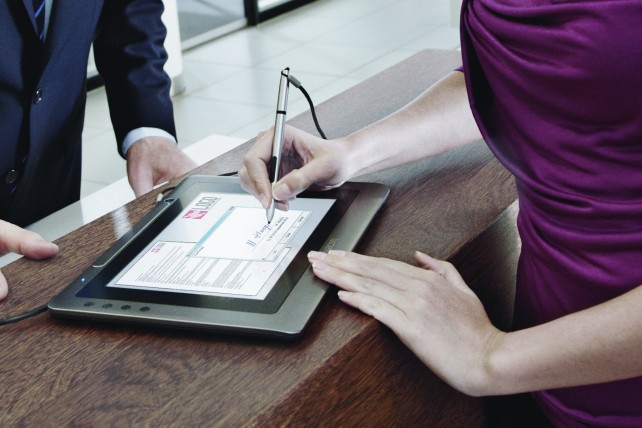At first glance, it’s difficult to see what the world of movie animation could have in common with procedures and reforms in the public sector. However, one company has taken the technology originally used in computer-aided design and film animation to create some of the most stunning and exciting box-office smashes, and is applying it to a routine business practice – the signing of a document.
For around 30 years, Wacom – founded and headquartered in Japan, with offices in Europe, the United States and China – has been creating products and services that help industry leaders push the boundaries of film and 3D animation in industry design, digital art and game development. Having created pen technology for tablets, it began ten years ago to take the same high-tech, innovative approach to electronic handwritten signatures.
Over the last few years, banking and other commercial sectors around the world have been enjoying the huge benefits offered by electronic handwritten signatures, but now a growing number of public-sector organisations are beginning to use Wacom’s technology to cut costs, speed up processes and achieve their sustainability targets.
The requirement to go paperless in 2018 is adding further impetus. Health Secretary Jeremy Hunt has called for any crucial health information to be available to staff at the touch of a button, while PwC calculates that £4.4 billion could be invested back into the NHS with better use of information and technology. Electronic handwritten signatures are a key part of this goal.
There is a wide range of benefits that flows from electronic handwritten signatures. For example, they avoid the need for a single piece of paper to circulate in an office during which time it could risk getting lost, damaged or falling into the wrong hands. Another advantage that the private sector and now public bodies around the world are discovering is that parties can sign a document even if they’re not physically present in the office.
This digital technology offers significant savings. It’s estimated, for instance, that around 18 per cent of all UK office floor space is devoted to storing paper, so the cost-reduction of going paperless is huge. Not only that, but electronic handwritten signatures are now accepted in legal proceedings, and their use is approved for various formal documents, such as passports, ID cards and access cards.
But not all electronic signature technology is the same, hence the concerns among many public and private-sector organisations. “People worry that signatures will not be captured accurately and so they are afraid of fraud,” explains Mark Hoole, eDocs UK key account manager at Wacom Europe GmbH. “But what we offer is a world away from the crude, pixelated electronic-signature device that many people are familiar with when they’ve signed for a delivery, for instance.”
Wacom systems use highly sophisticated technology to ensure the greatest possible accuracy and security. Screens have a very high resolution and, along with the pens, they pick up minute biometric data, including every movement and subtle nuance of the human hand as it writes. This could also mean the speed, force and angle at which the pen hits the screen, how i’s are dotted and t’s crossed, the way people create loops when writing, and even how long it takes for the person signing to move from one letter to the next are measured and recorded with minute precision.
“This remarkable level of accuracy, combined with the signature being captured only as a data stream, using a Wacom pen and screen means that signature fraud could become a thing of the past,” says Mr Hoole. “This is one of the reasons why so many banks use the company’s technology. It also gives the experience of a natural signature.”
Even with this high level of security, the systems are flexible. Thanks to a wide range of pens, Wacom technology also works easily with tablets and smartphones. The screens and pens are remarkably tough. In one test, even after half a million signatures, the screen was unmarked. “What a lot of clients also like is that when no one is signing on it, the screen can be used to display important information and messages,” adds Mr Hoole.
Electronic handwritten signatures offer so many advantages to the public sector and meet so many of its growing requirements. Now they have a product that, thanks to its superior technology, is safe, flexible and cost effective.
For more information please visit http://signature.wacom.eu/
WACOM SIGNATURE PRODUCTS
STU-530
With its 5-inch high-resolution colour LCD screen, the STU-530 is the ideal signature pad for high-traffic patient, visitor or client counters. It’s very easy and comfortable to use thanks to its low-profile flat surface. In addition to capturing handwritten signatures, it can be used for branding, marketing or advertising purposes. The pen features 1,024 levels of pressure sensitivity for natural signature capturing. Each unit is assigned a unique hardware ID to identify any signatures signed on it.
DTU – 1031
The DTU-1031’s 10.1-inch signature display, state-of-the-art encryption and the ability to accept written input directly into the monitor makes it ideal for organisations that need a display with a minimal footprint, which allows users to view or complete full-size documents and sign them digitally.

WACOM SIGNATURE PRODUCTS
STU-530


